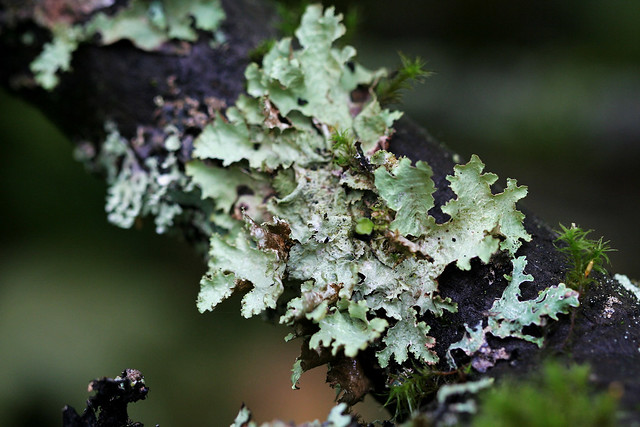The key difference between photobiont and mycobiont is that photobiont refers to the photosynthetic component of the lichen, which is a green alga or a cyanobacterium, while mycobiont refers to the fungal component of lichen, which is mainly an ascomycete or a basidiomycete.
There are different kinds of symbiotic relationships between living organisms. A symbiotic relationship is an association in which two different species of organisms live together. Moreover, parasitism, mutualism and commensalism are three types of symbiotic relationships. Mutualism is beneficial for both parties. Lichen is such a kind of a mutualistic association that exists between an algae/cyanobacterium and a fungus. In this association, one party is responsible for the production of food by photosynthesis while the other party is responsible for the absorption of water and providing shelter. Based on this, alga/cyanobacterium is known as the photobiont which carries out photosynthesis, while the fungus is known as the mycobiont which provides shelter and absorbs water.
CONTENTS
1. Overview and Key Difference
2. What is Photobiont
3. What is Mycobiont
4. Similarities Between Photobiont and Mycobiont
5. Side by Side Comparison – Photobiont vs Mycobiont in Tabular Form
6. Summary
What is Photobiont?
Photobiont is the photosynthetic partner of the lichen. It is responsible for the production of carbohydrates or food by photosynthesis. It can be a green alga or a cyanobacterium. Both are able to carry out photosynthesis since they have chlorophylls.

Figure 01: Lichen
However, when comparing green algae and cyanobacteria, algae contribute more towards forming lichens with fungi than cyanobacteria.
What is Mycobiont?
Mycobiont is the fungal partner of the lichen; it is a filamentous fungus. It is responsible for the absorption of water and providing shade to the photobiont. Generally, fungi of ascomycetes and basidiomycetes form this kind of symbiotic association with algae or with cyanobacteria.

Figure 02: Photobiont and Mycobiont in a Lichen
Generally, only one species of fungi can be seen in lichen. Thus, it can be either an ascomycete or a basidiomycete.
What are the Similarities Between Photobiont and Mycobiont?
- Photobiont and mycobiont are two components which live together in a lichen.
- Moreover, they are in a mutualistic association with each other.
- Hence, both are beneficial to each other.
- They live for a long time while growing slowly.
What is the Difference Between Photobiont and Mycobiont?
Photobiont and mycobiont refer to the photosynthetic partner and fungal partner in a lichen, respectively. So, this is the key difference between photobiont and mycobiont. Usually, photobiont carries out photosynthesis and produces food, while mycobiont absorbs water and provides shelter to the photobiont. Therefore, this is the functional difference between photobiont and mycobiont.
Moreover, photobiont is usually an alga or a cyanobacterium, while mycobiont is usually an ascomycete or a basidiomycete.

Summary – Photobiont vs Mycobiont
Lichen has two components as photobiont and mycobiont. Photobiont refers to the photosynthetic component, while mycobiont refers to the fungal component of the lichen. Usually, photobiont is an alga or a cyanobacterium which is photosynthetic. On the other hand, mycobiont is usually an ascomycete or a basidiomycete. Thus, this summarizes the difference between photobiont and mycobiont.
Reference:
1. “Lichen.” Encyclopædia Britannica, Encyclopædia Britannica, Inc., 27 Sept. 2018, Available here.
Image Courtesy:
1. “A little lichen” By Bradley Davis (CC BY 2.0) via Flickr
2. “05 02 interactions green alga (green), fungal hypha, lichen, Lichenes (M. Piepenbring)” By M. Piepenbring – (CC BY-SA 3.0) via Commons Wikimedia
ncG1vNJzZmivp6x7pbXFn5yrnZ6YsqOx07CcnqZemLyue8OinZ%2Bdopq7pLGMm5ytr5Wau268x6irqJqZpLu1ecCnm2alqZi8o7XOp6to